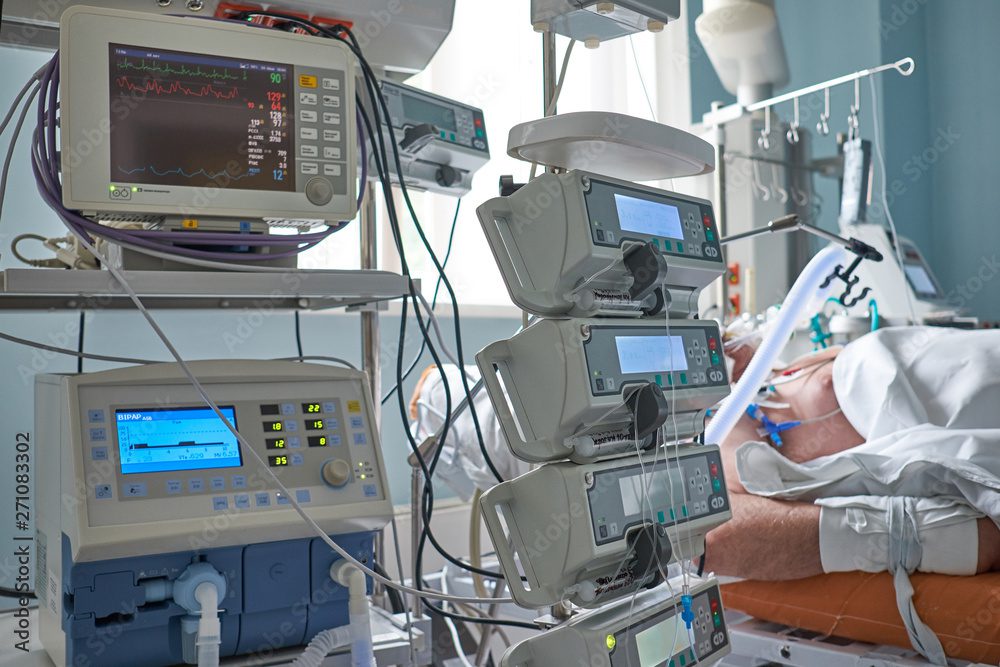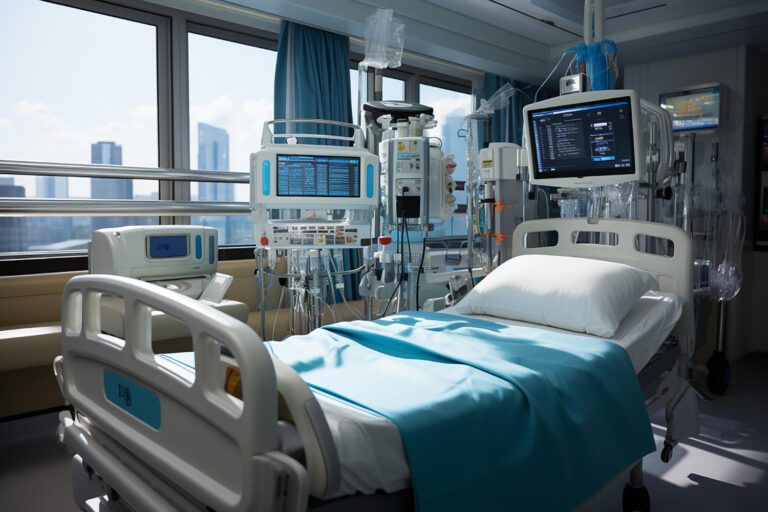
Did you know that a well-equipped intensive care unit (ICU) can save up to 30% more lives, especially for critical illnesses and the emergency resuscitation of many patients? Intensive Care Essential Equipment List, such as a crash cart, CPAP, and ventilator, plays a crucial role in providing effective critical care and improving patient outcomes.
Intensive essential care equipment lists ensure preparedness and organization in a fast-paced environment where every second counts. This includes having a crash cart for emergency resuscitation, as well as equipment for critical illness management and patient monitoring.
From catheters and ventilators to crash carts and CPAP machines, each piece of equipment serves a specific purpose in monitoring and supporting critically ill patients. Cardiac monitors ensure the patient’s heart is functioning properly, while infusion pumps deliver the necessary medications.
Defibrillators are used in emergency situations to restore a normal heart rhythm. Throughout the hospital, alarms on these devices provide important notifications to healthcare providers. Understanding the role of different types of equipment, such as IV pumps, catheters, and tubes, is key to providing timely interventions and optimizing patient care.
Table of Contents
- 0.1 Intensive Care Essential Equipment List
- 0.1.1 ICU Beds: Providing Comfort and Functionality for Critical Care
- 0.1.2 Advanced Features for Precise Measurements
- 0.1.3 Patient Monitors: Vital Signs Monitoring for ICU Patients
- 0.1.4 Non-invasive methods used to track patients’ health status in real-time
- 0.1.5 Early detection of abnormalities through advanced alarm systems integrated into monitors
- 0.1.6 Integration with electronic medical records for accurate data analysis and trend tracking
- 0.1.7 Airway Management: Ensuring Proper Ventilation and Oxygenation
- 0.2 Ventilators: Essential Life-Support Devices
- 0.3 Hemodialysis Machines: Filter Waste and Maintain Electrolyte Balance
- 0.4 The Role of Specialized Equipment in Saving Lives
- 0.5 Conclusion
- 0.5.1 FAQs
- 0.5.2 What are some common types of ventilators used in ICUs?
- 0.5.3 How often should patient monitors be calibrated?
- 0.5.4 Are there any specific safety measures for operating hemodialysis machines?
- 0.5.5 Can ICU beds be customized for patient comfort?
- 0.5.6 What is the role of airway management in the ICU?
- 1 Subscribe to our Newsletter
Intensive Care Essential Equipment List
ICU Beds: Providing Comfort and Functionality for Critical Care
Intensive care units (ICUs) in hospitals play a crucial role in providing specialized care to critically ill patients. One of the key components of these critical care units is the ICU bed. These beds are designed with specific features that prioritize both patient comfort and functionality for healthcare professionals. Let’s explore some of the essential aspects of ICU beds that contribute to effective critical care.
Adjustable Features for Patient Comfort
ICU beds are equipped with adjustable features that allow healthcare providers to customize the bed according to each patient’s unique needs. The ability to adjust height, backrest, and leg rest ensures optimal positioning for patients during extended stays in the ICU. This adjustability not only enhances patient comfort but also aids in preventing complications such as pressure ulcers or respiratory issues caused by improper positioning. This makes the ICU beds an important component of the essential intensive care equipment list.
Specialized Designs for Easy Access
In a critical care setting, quick and easy access to patients is paramount. ICU beds are designed with this requirement in mind, featuring specialized designs that facilitate accessibility for healthcare professionals.
The open-frame design allows medical staff to approach patients from any angle, ensuring efficient monitoring and treatment without any obstructions. Removable headboards and footboards provide convenient access points for medical equipment or interventions.
Safety Mechanisms to Prevent Accidents
Patient safety is of utmost importance in an ICU setting, which is why ICU beds come equipped with various safety mechanisms. Side rails on the bed can be raised or lowered as needed, providing support and preventing accidental falls during patient transfers or movements.
Bed alarms are also installed to alert healthcare providers if a patient attempts to leave bed without assistance, ensuring timely intervention and preventing potential injuries.
Advanced Features for Precise Measurements
ICU beds often incorporate advanced features that aid in precise measurements without causing discomfort or disturbance to patients. For example, built-in scales allow accurate weight measurements while the patient remains in bed. This eliminates the need for separate weighing procedures, reducing patient discomfort and minimizing the risk of injury during transfers.
Patient Monitors: Vital Signs Monitoring for ICU Patients
Patient monitors are other important intensive care equipment that play a crucial role in the intensive care unit (ICU) by continuously monitoring the vital signs of critically ill patients. These devices are designed to track important indicators such as heart rate, blood pressure, and oxygen levels in real time. Let’s explore how patient monitors contribute to the well-being of ICU patients.
Continuous monitoring of vital signs such as heart rate, blood pressure, and oxygen levels
Patient monitors allow healthcare professionals to closely monitor the vital signs of ICU patients. These devices use non-invasive methods to track important health parameters without causing discomfort or pain to patients. By continuously measuring metrics like heart rate, blood pressure, and oxygen saturation levels, patient monitors provide valuable information about a patient’s overall health status.
Non-invasive methods used to track patients’ health status in real-time
One of the key advantages of patient monitors is that they utilize non-invasive techniques for monitoring ICU patients. This means that healthcare providers can gather essential data without resorting to invasive procedures or interventions.
For example, instead of inserting an arterial catheter for continuous blood pressure measurement, patient monitors can use a cuff-based method that inflates around the patient’s arm at regular intervals.
Early detection of abnormalities through advanced alarm systems integrated into monitors
Patient monitors are equipped with advanced alarm systems that help detect abnormalities or deviations from normal values promptly. When any vital sign falls outside predetermined ranges, these alarms alert nurses and other medical staff immediately. Early detection enables healthcare professionals to intervene quickly and provide appropriate treatment or intervention before a condition worsens.
Integration with electronic medical records for accurate data analysis and trend tracking
To ensure accurate data analysis and trend tracking, patient monitors are often integrated with electronic medical record (EMR) systems used in hospitals. This integration allows seamless transfer of vital measurements from the monitor directly into the patient’s digital health record.
This not only eliminates the need for manual data entry but also enables healthcare providers to review historical trends and make informed decisions about a patient’s condition.

Airway Management: Ensuring Proper Ventilation and Oxygenation
According to intensive care unit guidelines, one of the most critical aspects of patient care is maintaining a patient’s airway to ensure proper breathing support. This involves employing various techniques and utilizing specialized devices to establish and monitor the airway. Let’s explore some key points about airway management in the ICU.
Techniques for Establishing a Patent Airway
There are several techniques that healthcare professionals may employ. These techniques aim to ensure adequate ventilation and oxygenation for patients in need of respiratory support. Some common methods include:
-
- Endotracheal Tubes: These tubes are inserted through the mouth or nose into the trachea, allowing direct access to the lungs for mechanical ventilation. They are often used during surgeries or in cases where patients require prolonged ventilatory support.
-
- Tracheostomy Tubes: In situations where long-term ventilatory support is needed, a tracheostomy tube may be inserted directly into an opening made in the neck called a stoma. This allows for easier access to the trachea for breathing assistance.
-
- Supraglottic Airways: These devices, such as laryngeal mask airways (LMAs), are placed above the vocal cords but below the glottis to maintain an open airway during procedures requiring sedation or general anesthesia.
Continuous Monitoring of Proper Oxygenation Levels
Monitoring oxygen levels is of utmost importance in the intensive care unit (ICU) to ensure that patients receive the necessary amount of oxygen throughout their stay. This continuous monitoring is essential as it helps healthcare providers identify any changes or abnormalities in oxygen levels promptly, allowing them to intervene when necessary. One common method used for monitoring oxygen saturation levels is pulse oximetry. This non-invasive technique involves attaching a probe to a patient’s finger or earlobe. The probe uses light to measure the amount of oxygen the red blood cells carry.
By continuously monitoring oxygen saturation levels, healthcare providers can quickly detect any decrease or increase in oxygen levels, which could indicate respiratory distress or other complications.
Arterial Blood Gas Analysis (ABG)
Another important monitoring method in the ICU is arterial blood gas analysis (ABG). ABG tests provide more detailed information about the patient’s blood oxygen levels, carbon dioxide levels, and acid-base balance. These tests are typically performed by drawing a small blood sample from an artery, usually from the wrist or groin area.
The blood sample is then analyzed in the laboratory to determine the levels of oxygen and carbon dioxide in the blood, as well as the pH level and other parameters related to acid-base balance. By regularly monitoring arterial blood gases, healthcare providers can gain valuable insights into a patient’s respiratory function and overall acid-base balance.
Transcutaneous Blood Gas Analysis
In recent years, there has been a significant advancement in the field of intensive care equipment, particularly in the area of transcutaneous blood gas analysis. This innovative technology has quickly gained recognition and become an integral part of ICU settings.
Transcutaneous blood gas analysis is a noninvasive method of measuring blood gases, such as oxygen and carbon dioxide levels, through the skin. It offers numerous benefits compared to traditional arterial blood gas sampling, including reduced patient discomfort and eliminating potential complications associated with invasive procedures.
The process involves using a specialized sensor placed on the patient’s skin, typically on the chest or abdomen. The sensor contains electrodes that measure the partial pressure of gases diffusing through the skin.
These measurements provide valuable insights into the patient’s respiratory and acid-base balance, enabling healthcare professionals to make informed decisions regarding ventilation management and overall patient care. One key advantage of transcutaneous blood gas analysis is its real-time monitoring capability.
Continuous monitoring allows medical staff to closely track changes in blood gas levels over time, providing immediate feedback on the effectiveness of interventions and treatments. This real-time data enables early detection of abnormalities or fluctuations, allowing for prompt intervention and adjustment of therapy if necessary.
Prompt Intervention during Airway Emergencies
Airway emergencies can occur suddenly and require immediate intervention to prevent further complications or even loss of life. In the ICU, healthcare providers are equipped with specialized tools to address such emergencies effectively. These tools may include:
-
- Bag-Valve-Mask (BVM) devices: These manual resuscitators allow for manual ventilation when a patient’s breathing is compromised.
-
- Suction Devices: Used to clear secretions or foreign objects from the airway, suction devices help maintain a patent airway in emergency situations.
Ventilators: Essential Life-Support Devices
Mechanical ventilation is a crucial aspect of intensive care, providing respiratory support for critically ill patients. In the ICU, ventilators are indispensable life-support devices that help patients breathe when they are unable to do so on their own. Let’s delve into the key features and functions of these essential machines.
Ventilators offer various ventilation modes to cater to the specific needs of individual patients. These modes include pressure control, volume control, and positive end-expiratory pressure (PEEP). Pressure control mode delivers breaths at a set pressure, ensuring consistent airflow during inspiration. Volume control mode, on the other hand, delivers breaths with a predetermined tidal volume, maintaining proper oxygenation levels. PEEP is used to keep the airways open by applying positive pressure at the end of expiration.
Modern ventilators come equipped with advanced features that enhance respiratory management in the ICU. These features include adjustable inspiratory and expiratory times, allowing healthcare professionals to tailor ventilation settings according to patient requirements. Alarms and alerts help monitor changes in a patient’s condition or any potential issues with ventilation parameters. Ventilators are absolutely necessary in intensive care units, making them an essential part of the equipment list.
Integration with Patient Monitors
To ensure comprehensive monitoring and management of respiratory functions, ventilators can be seamlessly integrated with patient monitors. This integration enables continuous monitoring of vital signs such as heart rate, blood pressure, oxygen saturation, and carbon dioxide levels.
Having all this information readily available on one screen or system interface allows healthcare providers to make informed decisions regarding patient care.
Ventilators have numerous advantages in the field of intensive care equipment. They play a crucial role in saving the lives of critically ill patients by providing respiratory support. These devices offer different modes that can be tailored to meet the specific requirements of each patient.
On the other hand, ventilators have some drawbacks. Prolonged use of these devices may lead to ventilator-associated complications, which need to be carefully monitored and managed. Patients using ventilators may also experience discomfort and face difficulties in communicating effectively.
Ventilators require regular maintenance and calibration to maintain their optimal performance. This ensures that they continue to function efficiently and provide the necessary support to critically ill individuals.
Hemodialysis Machines: Filter Waste and Maintain Electrolyte Balance
Hemodialysis machines are vital in managing kidney failure by effectively removing waste products from the blood. These machines are specifically designed to filter out toxins and excess fluids that the kidneys can no longer eliminate on their own.
One key function of hemodialysis machines is the precise regulation of electrolyte levels in the body. Electrolytes, such as sodium, potassium, and calcium, are essential for maintaining proper bodily functions.
However, when the kidneys fail, these electrolyte levels can become imbalanced. Hemodialysis machines ensure electrolytes are carefully monitored and adjusted during each dialysis session to maintain a healthy balance.
During hemodialysis sessions, continuous monitoring of vital parameters is crucial. The machines have advanced sensors that measure blood pressure, heart rate, oxygen saturation levels, and other critical indicators. This real-time monitoring allows healthcare professionals to closely observe changes or abnormalities in a patient’s condition during treatment.
Monitoring vital parameters is crucial
Integration with patient records is another significant feature of modern hemodialysis machines. By connecting with electronic health record systems, these machines enable accurate documentation of dialysis treatments. This integration ensures that all relevant information about a patient’s dialysis sessions is recorded and easily accessible for future reference.
In terms of functionality, hemodialysis machines consist of various components working together seamlessly:
-
- Dialysis Machine: The central unit that filters waste products from the blood.
-
- Catheter: A tube inserted into a large vein to allow access to the bloodstream.
-
- Fluid Pumps: Regulate the flow rate of dialysate (a special fluid used in hemodialysis) through the machine.
-
- Blood Pressure Monitor: Measures blood pressure throughout the treatment process.
-
- ECG Electrodes: Used to monitor electrical activity in the heart during dialysis.
-
- Blood Tubing Set: Connects the patient’s blood vessels to the dialysis machine.
-
- NG (Nasogastric) Tube: Occasionally used to remove excess fluid from the stomach during treatment.
The effectiveness of hemodialysis machines in managing kidney failure is well-established. They have significantly improved the quality of life for countless individuals with end-stage renal disease. By efficiently removing waste products and maintaining electrolyte balance, these machines help patients regain stability and function.
The Role of Specialized Equipment in Saving Lives
Every second counts in the high-pressure environment of intensive care units (ICUs). That’s why specialized intensive care essential equipment list plays a crucial role. These highly advanced machines and devices are designed to address critical care needs and provide rapid response capabilities for effectively handling life-threatening emergencies.
Highly specialized equipment designed to address specific critical care needs
Intensive care units require a range of specialized equipment to cater to the diverse needs of critically ill patients. From emergency resuscitation to ongoing monitoring and treatment, these devices are essential for providing immediate assistance and ensuring optimal patient outcomes.
Examples of such specialized equipment include:
-
- ECMO machines: Extracorporeal Membrane Oxygenation (ECMO) machines act as an artificial lung by oxygenating the blood outside the body. They are used in cases where traditional ventilation methods are insufficient, providing vital support for patients with severe respiratory failure or cardiac arrest.
-
- Intra-aortic balloon pumps: These devices help maintain blood flow and circulation in patients with compromised heart function. By inflating and deflating a balloon within the aorta, they assist the heart in pumping blood effectively, especially during episodes of heart failure or following cardiac surgery.
-
- Cardiac defibrillators: Defibrillators deliver an electric shock to restore normal heart rhythm in individuals experiencing life-threatening cardiac arrhythmias such as ventricular fibrillation or ventricular tachycardia. They play a pivotal role in saving lives during sudden cardiac arrests.
Rapid response capabilities to handle life-threatening emergencies effectively
In critical situations, time is of the essence. Specialized ICU equipment is designed with rapid response capabilities that allow healthcare professionals to intervene quickly and efficiently during emergencies. These devices often come equipped with alarms and alerts that signal any abnormalities or changes in a patient’s condition, enabling healthcare teams to take immediate action.
It is vital to collaborate with healthcare professionals to use specialized equipment effectively. The ICU team, consisting of doctors, nurses, respiratory therapists, and other specialists, works together to utilize these machines effectively. Their expertise and knowledge, combined with the equipment’s capabilities, ensure that patients receive timely and appropriate care.
Conclusion
You’ve made it through an in-depth exploration of the intensive care essential equipment list used in intensive care units. By now, you understand just how crucial it is to have a comprehensive list. This list serves as a lifeline for critical patient care, ensuring that healthcare professionals have all the necessary tools at their disposal to provide optimal treatment and support.
Equipping an ICU with the right tools can be likened to assembling a well-prepared team for battle. Each piece of equipment plays a vital role, just like every soldier on the front line. From ICU beds that offer comfort and functionality to patient monitors that diligently track vital signs, these tools are the unsung heroes that aid medical professionals in saving lives.
FAQs
What are some common types of ventilators used in ICUs?
Ventilators play a critical role in supporting patients who cannot breathe adequately on their own. Some commonly used ventilators include pressure-cycled ventilators, volume-cycled ventilators, and dual-mode ventilators. These devices deliver oxygen-enriched air into the lungs while maintaining proper ventilation.
How often should patient monitors be calibrated?
To ensure accurate reading, patient monitors should be calibrated regularly according to manufacturer guidelines and hospital protocols. Calibration frequency may vary depending on factors such as usage patterns and hospital policies, but typically occurs at least once per year.
Are there any specific safety measures for operating hemodialysis machines?
Yes, operating hemodialysis machines requires adherence to strict safety protocols. Healthcare professionals must follow infection control guidelines, maintain a sterile environment, and regularly check for any leaks or malfunctions in the machine. Proper training and certification are essential for safely operating these machines.
Can ICU beds be customized for patient comfort?
Yes, ICU beds often come with various adjustable features that can be customized to enhance patient comfort. These features may include adjustable height, backrest inclination, leg elevation, and pressure redistribution surfaces to prevent bedsores.
What is the role of airway management in the ICU?
Airway management involves ensuring proper ventilation and oxygenation for patients in critical care. This includes techniques such as intubation, tracheostomy, and non-invasive ventilation to secure and maintain a patent airway, allowing adequate gas exchange.
Remember that healthcare decisions should always be made in consultation with medical professionals who have a complete understanding of your specific situation.


